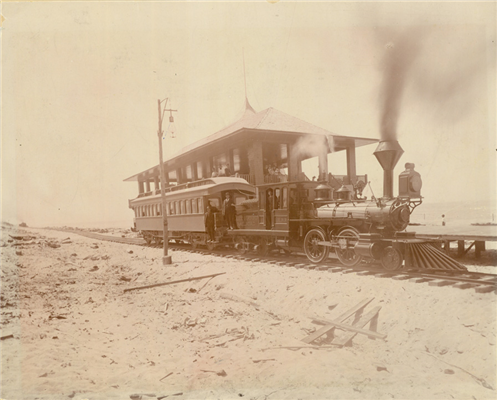- Details
- Hits: 2361
Railroad: Lake Harbor Railroad
Built → Lake Harbor Railroad → Abandoned
Built: 1892 by Chicago & West Michigan interests and others. Used tracks of the Muskegon Lake railroad.
Operated for 3 years.
Removed: Track removed in 1895
Reference: [CMH-MRHS]
 Photo Info: A Chicago & West Michigan train visits the Lake Harbor depot in 1894. [Charles Yates collection]
Photo Info: A Chicago & West Michigan train visits the Lake Harbor depot in 1894. [Charles Yates collection]
Notes
In 1892, the Lake Harbor Railroad was created by Charles M. Heald (General Manager of the Chicago and West Michigan Railroad), Frederick A. Nims, and George L. Irwin, to be a seasonal waterfront line serving Muskegon, Lake Michigan Park, and Lake Harbor.
Lake Harbor had grown into a major summer destination with several large hotels, including the Lake Harbor Hotel, which was considered second only to the Grand Hotel at Mackinac Island in Michigan in stature. The hotel was large enough to accommodate over 1,000 guests. The town was also the location of the Hackley Assembly Grounds which hosted major Chautauqua type events including the state assembly of the Methodist Episcopal churches, the state assembly of the Women’s Christian Temperance Union, the International Order of Good Templars, the National Sabbath Union, and the Michigan State Teacher’s Association.
The railroad was incorporated on July 4, 1892 with stated capital of $50,000., however since construction had been underwritten by the Chicago, and West Michigan Railroad, work on the line had been started earlier in June. The road hired the construction firm of Thompson and Dodge to build the line, and the mortgage on the railroad was held by the C&WM.
The officers of the railroad were, John W. Moon, President, Fredrick A. Nims Vice President, Thomas Munroe, Secretary, and W.B. McLaughlin, Treasurer. Other directors on the board were George L. Irwin, and Louis Kanitz.
The road was finished in August of 1892, and was immediately filled to its passenger capacity.
The railroad operated from Muskegon, along the south side of Muskegon Lake on the tracks of the former Muskegon Lake Railroad which had been built in 1881 to serve the lumber industry, and acquired by the Chicago and West Michigan in 1886. The MLR tracks terminated at the Muskegon harbor entrance at Port Sherman, also known as Eldred’s due to the presence of the large Eldred Lumber Company mill at the location.
Notably, this line later served the C&WM’s cross lake ferry docks at Port Sherman, beginning when the company in 1898 purchased a car ferry from the United States and Ontario Navigation Co. called the Shenango #2. When the Pere Marquette absorbed the C&WM, the ship was sent to Ludington and was renamed “Pere Marquette 16”. The Muskegon slip was then abandoned. [1] below.
The route of the Lake Harbor, was along the beach from Lake Michigan Park to a station at the north side of the mouth of Mona Lake which was named Lake Harbor Beach station. However, the Lake Harbor was granted operating rights on all of the trackage of the former Muskegon Lake Railroad. Trains operated from Lake Harbor directly to and from the City of Muskegon, ran afternoon trains between the lakefront stations, and routinely ran specials to Port Sherman to meet excursion ships on week-ends.
At the end of the 1895 summer season, disagreement among the management of the Hackley Assembly Grounds resulted in the dissolution of the association, and the liquidation of the property. The Methodist Episcopal state assembly announced its move to Ionia, a more central location, and the general economic fall-out from the Panic of 1893 had resulted in greatly reduced attendance to events at Lake Harbor.
While storm damage had caused some significant track washouts and repair expenses in the previous years, the Chicago & West Michigan decided to dissolve the Lake Harbor due to the C&WM’s heavy investment in its Ottawa Beach resort at Holland, which was suffering from depressed leisure business. The railroad was concerned that there would be no further events held at Lake Harbor as the assembly grounds situation was in limbo, and Lake Harbor as a community was too small to sustain a railroad on its own. The C&WM, having greatly expanded into other markets, had no special interest in the area, and the Lake Harbor only served the C&WM’s competitors in the hotel and resort business when operational.
Although the Lake Harbor Railroad was profitable every year of its existence, its tracks were removed, the work beginning on October, 6 1895. The railroad operated for four seasons, carrying tens of thousands of passengers and tons of freight with out mishap, which was unusual for its era.
The Lake Harbor Hotel lasted several decades after the end of the Lake Harbor Railroad. With the removal of trackage, the hotel operated steamboats from the hotel docks at the western end of Mona Lake, to the C.& W.M. (later) Pere Marquette seasonal platform at the far eastern end of the lake.The former Lake Harbor Beach railroad station was purchased by the hotel company, cut into sections, loaded onto scows, and shipped to Ferrysburg, where it was transported to the platform at Mona Lake by rail. There it was reassembled and used as the hotel steamboat docks.
The hotel operated successfully until it was destroyed by fire in May of 1918.
[From Mark Henricks and the Muskegon Railroad Historical Society]
Time Line
Footnote:
[1] Fredrickson, Arthur C. and Lucy F. "Pictorical History of the C&O Train and Auto Ferries". Lakeside Printing Co., Ludington, MI Revised 1965.
Bibliography
The following sources are utilized in this website. [SOURCE-YEAR-MMDD-PG]:
- [AAB| = All Aboard!, by Willis Dunbar, Eerdmans Publishing, Grand Rapids ©1969.
- [AAN] = Alpena Argus newspaper.
- [AARQJ] = American Association of Railroads Quiz Jr. pamphlet. © 1956
- [AATHA] = Ann Arbor Railroad Technical and Historical Association newsletter "The Double A"
- [AB] = Information provided at Michigan History Conference from Andrew Bailey, Port Huron, MI

